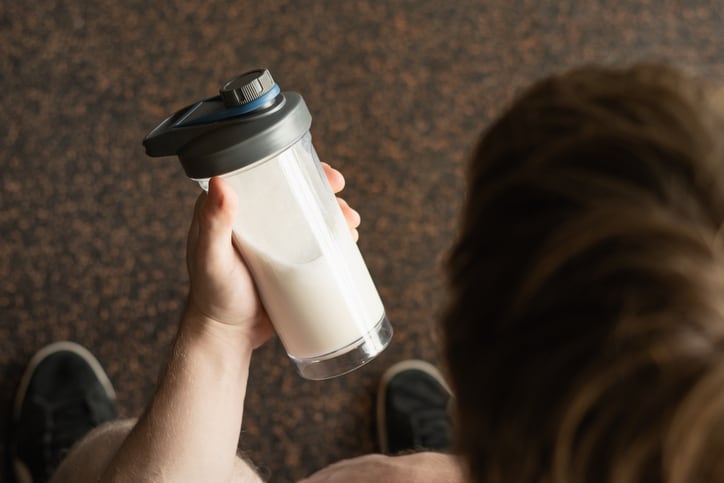Creatine is one of the most well-researched and widely used supplements in sports nutrition. The compound has gained even more popularity in recent years as more consumers become educated on benefits that extend far beyond athletic performance, including cognitive function, bone health and cardiovascular support. There is also a growing body of evidence that recognizes creatine’s role in women’s health, including healthy aging and reproductive health.
Despite the vast and ongoing research showing its safety and efficacy for various populations, some are calling creatine’s safety into question after Griffin experienced an unusual start to the final round of the BMW Championship due to what he referred to as a creatine “overdose.”
He described swallowing a large, hardened clump of creatine, which he referred to as a “snowball,” that had been sitting in his water bottle for a month. This led to him experiencing intense shaking and tremors, causing him to four-putt the first hole and hit his tee shot on the second hole out of bounds.
“I take creatine as a supplement, and this time I didn’t take it until I basically tee’d off on 1,” told reporters after his Sunday round at the BMW Championship. “I was at the end of my batch. I had basically a snowball of creatine—because it had been in my bucket for a month—and broke it up and put it in my water bottle. I’m all good. I’ve taken it on the golf course before. It’s fine.”
“I started taking it after my second shot, and I accidentally swallowed one of the big rocks in my water bottle. I’ve never ‘overdosed’ on creatine before, but I think I did in the moment because I didn’t really drink any water after that. I basically just inhaled a snowball. So, I started getting super shaky. I’ve never felt like that before and I felt like I had tremors.”
Griffin’s explanation led to a discussion among the creatine research community that highlighted confusion over dosages, the quality of the supplement and the scientific plausibility of such an overdose. While some experts suggest a physiological explanation for adverse reactions, others emphasized that such negative effects are not documented.
‘Symptoms could be plausible’
“He did not overdose, but from a biochemistry and physiology perspective, his purported symptoms could be plausible,” Darren Candow, PhD, director of the Aging Muscle and Bone Health Laboratory at the University of Regina in Canada, told NutraIngredients. “If you listen to his interview, he consumed a high dose of creatine (likely higher than 15 grams) on an empty or partially empty stomach right before teeing off.
“With very high dose creatine, there is some animal data showing that you can suppress endogenous synthesis which increases the availability of methyl groups for other processes. Creatine is a very large scavenger of methyl groups. This is why there is research looking at creatine and homocysteine. It could be possible that more methyl groups were available for neurotransmitter and hormone (epinephrine) synthesis.”
Further, Dr. Candow explained to NI that the average PGA warmup is around 60 minutes. Thus, the increase in whole-body muscle contractions from repeated swings (in hot environments) which stimulate glucose disposal and kinetics, coupled with creatine’s possible influence on GLUT-4 translocation, may provide a possible influence on blood glucose levels, especially if no other nutrients at significant levels in the GI track were delaying creatine absorption kinetics.
Rick Kingston, PharmD, cofounder and president of regulatory and scientific affairs of SafetyCall International, which specializes in adverse event management, regulatory reporting and post-market surveillance, told NI that his company has not seen any safety signals regarding creatine in general, especially for routine and as labeled use.
“But misuse and large intake can certainly cause some unpleasant adverse effects such as kidney dysfunction leading to dehydration, GI effects and muscle cramping,” he said. “The take-home message here is don’t consume large quantities of any supplement, especially if the consumption is well beyond labeled directions. In this case, a ‘snowball’ of creatine doesn’t sound like a well controlled serving.”
The blame game
“Saying ‘creatine made me lose’ is quite a claim that sounds outlandish,” said sports nutritionist Susan Kleiner, PhD, owner of High Performance Nutrition consulting firm.
Kleiner not only recommends creatine to her clients, she has been taking it herself since the mid-1990s.
“I have never seen a product that clumps into rocks,” she said. “I don’t know what he is taking. I’m taking 10 grams of creatine a day, and I have no stomach issues—and I’m a 67-year-old lady. It bends reality for me.”
“But the caveat to that is the comment by Dr. Darren Candow, who is a world-renowned researcher in creatine, who makes a physiological case that if he, on an empty stomach, dumped 15 grams into his stomach, maybe there was a physiological explanation,” Kleiner said. “People have been doing this forever, but maybe he’s a unicorn and he had this reaction.”
Douglas Kalman, PhD, adjunct professor at Nova Southeastern and cofounder of Substantiation Sciences LLC, noted that the reports raise the question whether the golfer blamed creatine but was really taking a caffeinated pre-workout.
“His reported side effect of ingesting creatine is not consistent with the literature and scientific analysis of real or possible side effects of creatine in healthy human beings,” he said.
Robert Wildman, PhD, head coach at TYM Athletic Performance, said there is a lot to unravel from Griffin’s comments.
“From a physiological standpoint, creatine does not have an acute neurological effect that could yield a ‘super shaky’ experience and ‘tremors’ as evident in hundreds of research studies,” he explained. “So, from a practical standpoint, because there is not an immediate, in-the-moment performance benefit of creatine supplementation, taking creatine before a competitive round of golf isn’t commonly recommended.”
Professor Rick Kreider, PhD, director of the Exercise & Sport Nutrition Lab at Texas A&M University, chalked the “overdose” up to an excuse.
He said that creatine supplementation, even when consumed in 8 to 10 gram doses several times a day for months, does not cause any of the problems as described by Griffin.
“Was there anything else in the supplement (caffeine or simple sugars, etc.)? Creatine should also be in powder form, not clumped,” he said. “There is no reason to take creatine right before starting to play golf, and you can’t ‘overdose’ on creatine. It’s irresponsible to blame creatine supplementation for poor judgment and play or perpetuate this misinformation in the media.”
Dr. Kreider suggested that everyone turn their attention away from what he calls “misinformation” and focus on the facts, such as Part 1 and part 2 of the Common Myths About Creatine Supplementation as well as ISSN’s Position Stand on creatine supplementation.
“I think that what we should be talking about is how you want to make sure that whatever supplement you take, that the brand is an evidence-based, that they’ve done research on their ingredients and that it is third-party laboratory tested,” Kleiner said. “And if there’s other ingredients in there, don’t just blame creatine.”



